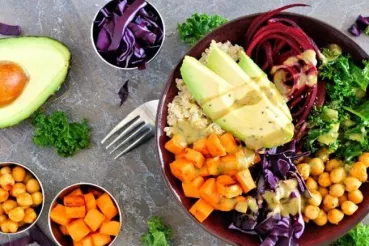For many of us, New Year's is when we commit (or re-commit) to healthier eating habits.
To help us get ready for a fresh start after the holidays, we rounded up some of our favorite diet tips of the past year.
8. Don’t fear fat.
If you think low-fat or fat-free products are better for you, check their labels. You might be surprised.
Some reduced-fat peanut butters and low-fat dressings actually have more calories than regular options thanks to added sugar, which s a major contributor to cardiovascular disease risk.
According to a number of recent studies, moderate portions of even saturated fats like butter don't increase the risk of heart disease as once thought. So if you can limit yourself to reasonable servings of full-fat products, go ahead and enjoy them.
7. Keep fruits and veggies whole.
Juicing is trendy these days, but you're much better off eating whole fruits and vegetables.
When you juice, you get rid of all the good fiber that helps you feel full. In general, fruit and vegetable juices don't give you that satiated feeling even though they have lots of calories, because they don't contain any protein.
Instead, make a smoothie using whole fruits and vegetables, plus protein like Greek yogurt (which has twice the protein of regular yogurt), milk or tofu.
6. Get your zzzzzzzz's.
People who get healthy amounts of sleep (at least seven hours a night) have an easier time maintaining a healthy weight.
There are a lot of reasons: First, when we're sleep-deprived, we tend to eat more overall and eat food that's less healthy — in part because sleep deprivation reduces activity in the brain's frontal cortex, where our rational decision-making (e.g., choosing to exercise, choosing healthy foods and practicing portion control) happens.
Sleep deprivation also affects the hormones ghrelin and leptin. Lack of sleep increases ghrelin levels (which leads to hunger and influences the body to use less energy and retain more fat) and decreases leptin, a hunger-controlling hormone.
5. Choose good-mood foods …
You know that eating your fruits and veggies is good for you — but they can literally make you feel good, too.
The journal BMC Medicine recently published a study showing that a diet made up mostly of vegetables, fruits, legumes and nuts can decrease your chances of depression, while foods like processed meats and sugar-heavy treats contribute to depression. Even moderate dietary changes significantly reduced study participants' risk of developing depression.
All foods can fit into a healthy lifestyle if you follow good portion-control habits and make sure your overall diet is well balanced.
4. … And feed your MIND.
Did you know that there's a diet that may help protect your brain as you age?
The MIND diet, developed by researchers at Rush, was found to reduce the risk of developing Alzheimer's disease and may also slow cognitive decline.
- One study showed that MIND lowered the risk of Alzheimer's by as much as 53 percent in participants who adhered to the diet rigorously, and by about 35 percent in those who followed it moderately well.
- A second Rush study — published online in the journal Alzheimer's & Dementia — revealed that older adults who followed the MIND diet more rigorously showed an equivalent of being 7.5 years younger cognitively than those who followed the diet least.
The diet involves eating 10 "brain-healthy" food groups — including green leafy vegetables, nuts, berries, beans, fish and olive oil — while avoiding five "unhealthy" groups (red meats, cheese, fried or fast foods, etc.).
Berries are the only fruit specifically to make the MIND diet. Blueberries are one of the more potent foods in terms of protecting the brain, and strawberries have also performed well in past studies of the effect of food on cognitive function. Fresh berries make a tasty topper for yogurt, oatmeal and whole grain cereal; and you can easily throw a handful — fresh or frozen — into the blender for a naturally sweet smoothie.
3. Go on a grocery adventure.
Make grocery shopping fun to keep yourself out of a boring food rut:
- Wander the aisles of an ethnic market and pick up produce that's new to you. For example, chayote squash, abundant at Hispanic markets, tastes like a cross between a zucchini and a cucumber and is delicious either raw or cooked. (Bonus: Prices are often lower at local ethnic markets than at national chains.)
- Buy a grain you've never heard of. If you're bored with rice and quinoa, try kamut, an ancient strain of wheat that's packed with protein and has a rich, nutty taste.
- Splurge on healthy, flavorful condiments like different varieties of vinegar. Try balsamic vinegar on leafy greens like kale and collards; the sweetness balances out the bitterness of the greens.
2. Remember that there are no no-nos.
Don't think about the color red for the next five minutes, no matter what.
Is your brain now overflowing with images of stop signs, strawberries, lipstick and clown noses?
The same thing happens with "forbidden" foods: If you forbid yourself from eating a brownie, next thing you know you'll be eating the whole pan because you feel deprived and can't think about anything else.
All foods can fit into a healthy lifestyle if you follow good portion-control habits and make sure your overall diet is well balanced. A suggestion for dealing with those brownies: Cut into controlled portions, wrap individually and freeze to enjoy one at a time.
1. Ask a dietitian.
Spend a few minutes watching a TV medical show or leafing through magazines in the grocery checkout line and you'll be inundated by often conflicting, frequently confusing diet advice.
For sound information and ideas for changing up your food routines, make an appointment to consult with a dietitian.




